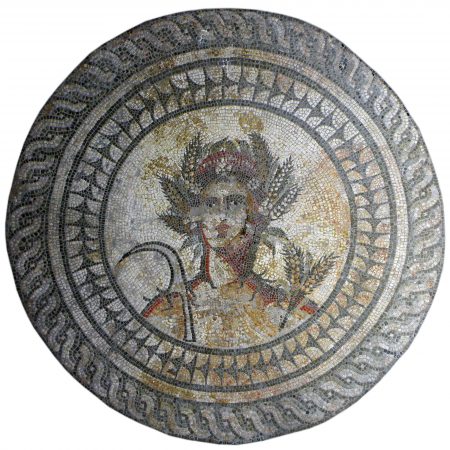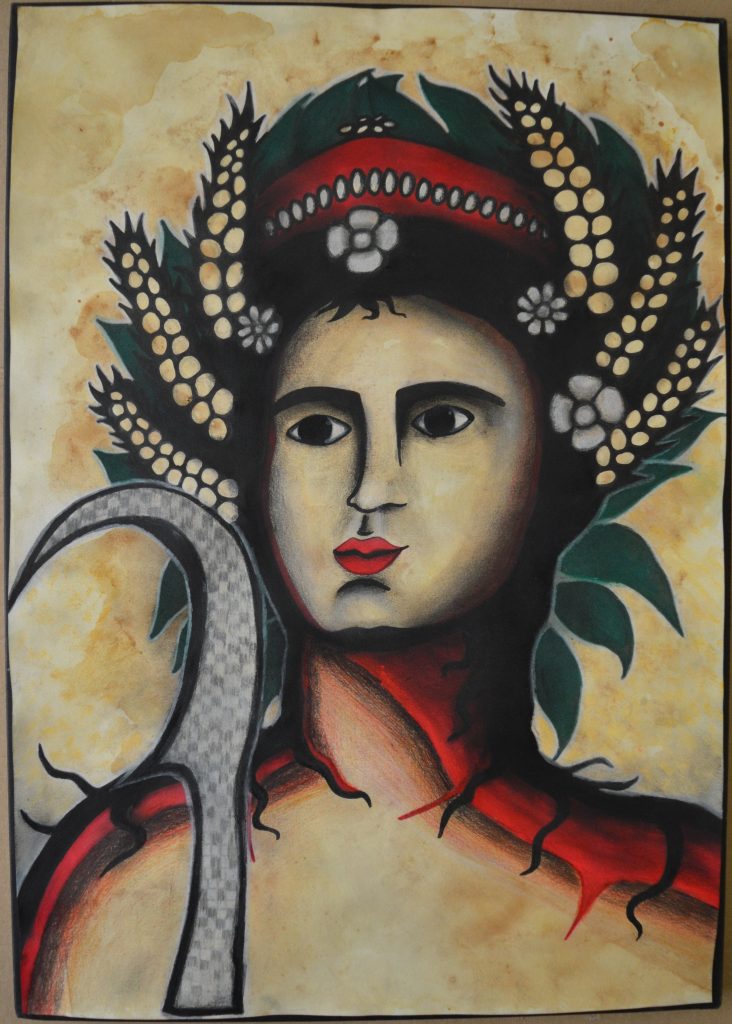Blog by Annabel Brodersen, Cirencester College
My name is Annabel, and I am a student at Cirencester College. I chose to volunteer at the Corinium Museum as a Creative Artist to explore the stories of the cultural artefacts here. I wanted to introduce storytelling into my art, so I presented the Summer mosaic of Ceres as a reflection of humanity in Roman mythology.
Ceres, the Roman goddess of agriculture, is depicted as Summer in the Seasons Mosaic as a celebration of the incoming harvest. Wreathed with flowers, leaves and corn-ears around a vermillion crown, her profile appears most striking due to its skilfully drawn and modelled creation, so she is the focus of my artwork as the humanisation of a divine figure.

The goddess’s figurative portrait exists in a roundel framed by an octagon, in a geometric mosaic design consisting of a nine-octagon grid within a square. Found in Dyer Street, Cirencester, in 1849, this highly impressive floor mosaic dating to the mid-2nd century illustrates Roman mythology, with the four seasons and scenes involving Bacchus, the god of wine and fertility. The four seasons are organised as the corner roundels of the mosaic, and each contain the figurative representation of the goddess relating to that season. For Spring, there is Flora, the goddess of flowers with a garland headdress; Ceres is Summer as the goddess of agriculture, carrying a sickle; for Autumn, Pomona, the goddess of the orchard, holds a pruning knife; and for Winter – now missing – there was probably a hooded goddess holding a bare branch.
Ceres wears the crop of her harvest: a crown of corn-ears, and the existence of a sickle symbolises the action of gathering grain with the curved blade in an annual agricultural ritual. I created an artwork depicting this goddess as I was inspired by her atmosphere of capability and the beauty of her form, with crimson tesserae used for the shadow on her neck and shoulders adding more colour variation to the piece. This vibrant red also contrasts with the bold, graphic tendrils of her black hair, alluding to her femininity, so her stylised form honours yet distances her as a divine symbol.

As a tribute to her divinity, I presented Ceres as a strong, powerful figure through capturing her intense stare into the distance, where she watches her mortal subjects with care. I wanted to bring out the vibrancy within the piece as well, partially clouded by time and use, and I achieved this through building up my artwork with layers: from a graphic pen base to a more bold, organic tribute for a deity. Using a tea and water base, I created an ancient background, reminiscent of the ochre yellow clouds in the roundel, while soft pastels and coloured pencils allowed me to emphasise the softness of her facial features. I used this tonal variation to illustrate Ceres with human qualities, while a fuller crown of corn-ears, flowers and leaves decorating her head conveys her divine importance.
It seems that as a goddess Ceres was expected to exist as two forms: the divine power and the capable worker. These opposing attributes are evident within her profile – she carries a sickle which an agricultural worker would use in the harvest; yet she seems to direct this gathering process, with her eye contact above, not meeting, the viewer. This duality of respect and reverence reflects the conflict in the relationship between Roman citizens and their gods, so alike them in human form yet so far removed. In modern culture, the portrayal of powerful women coexists as the idolisation of aesthetic, physically powerful symbols versus more genuine, complex human figures which are more relatable. Ceres acts as a symbol of hope, embodying the successful harvest which fed the Roman people, emphasising her role as a life-giving deity.
The Seasons Mosaic at the Corinium Museum immortalises Ceres as a divine Roman goddess, and inspires us to reflect on our connection with the past and its relevance to our lives today. Who better to celebrate the harvest with, than Ceres, goddess of agriculture!
By Annabel Brodersen










